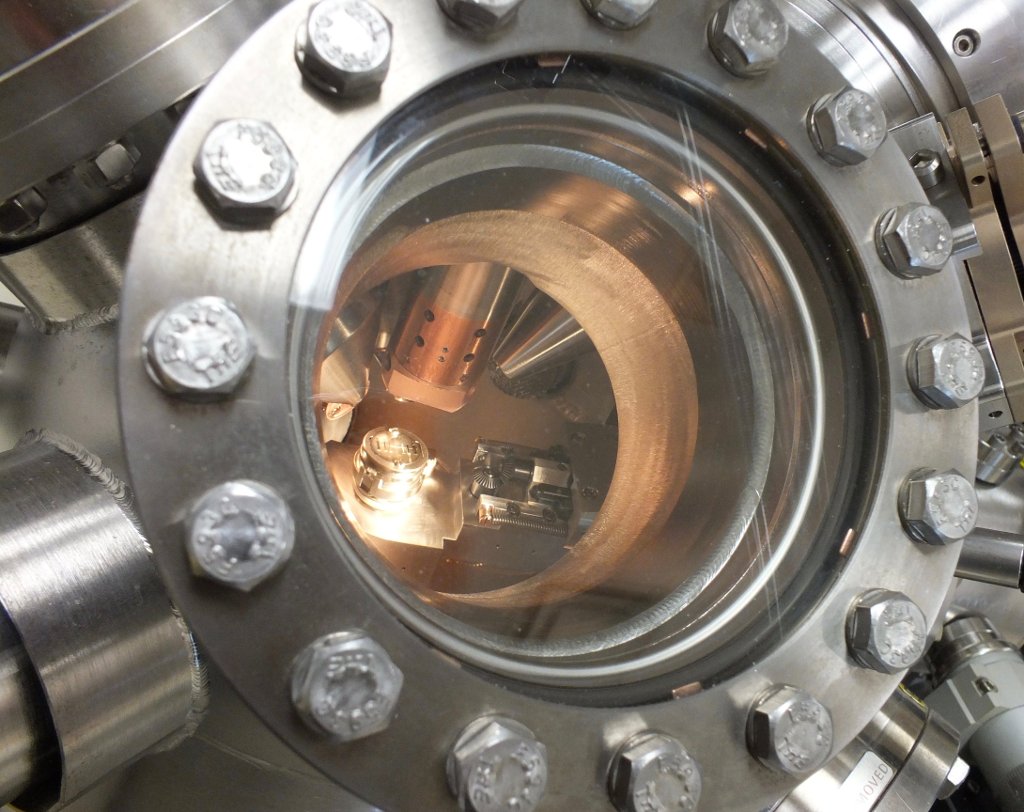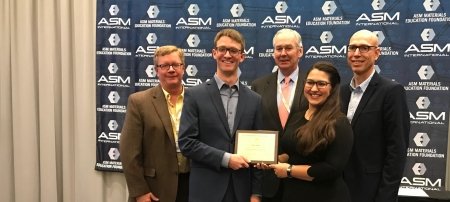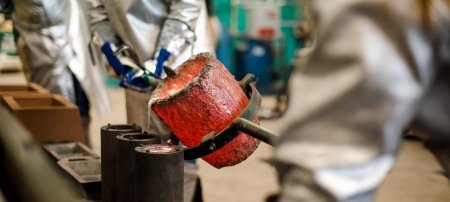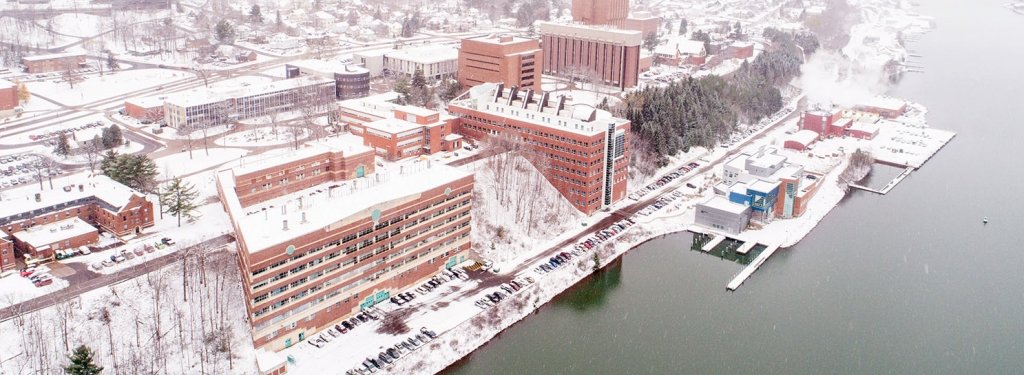ACMAL stands for Applied Chemical and Morphological Analysis Lab. In other words, it's THE lab on campus where basic science and fundamental materials engineering happens.
We politely call our University Marketing and Communications floor the "garden level." Anyone who has desperately looked for apartments knows that means "basement."
A lot of creativity happens in our basement. But we don't always get to see where the magic happens—or rather, The Science. So every once in a while, we set up lab tours; this time we visited ACMAL and got to see some of our most important and widely used research equipment on campus.
Lab Tour: Applied Chemical and Morphological Analysis Lab
What happens when the Michigan Tech writers and print folk and webmasters escape their garden level offices in the Admin building? Lab tours. We toured ACMAL, one of the core facilities on campus, where almost every STEM field comes to gather crucial data to characterize materials.
Yeah, we've got a pretty awesome comm crew. ACMAL facilities tour. 360 camera. Microscopy. Friday fun. #mtulive #engineering #scicomm pic.twitter.com/CnCFrarHcL
— MTU Research (@mturesearch) January 27, 2017
We joined several scientists and engineers on the ACMAL tour. They showed us equipment in each room used to characterize everything from sheets of metal to new minerals to solar panels to medical devices.
Welcome to the ACMAL tour! That's Applied Chemical and Morphological Analysis Lab and is a core facility on campus #materialsci #mtulive pic.twitter.com/55bmPtumrb
— MTU Research (@mturesearch) January 27, 2017
XRD: X-ray Diffraction
First up: XRD (X-ray diffraction) As Ed Laitila says: "Physics is the hub of science; materials science is the hub of engineering." #mtulive
— MTU Research (@mturesearch) January 27, 2017
XRD helps look at structure and composition in bulk samples. "Easy to use, difficult to interpret the data" -Lab Manager Ed Laitila #mtulive pic.twitter.com/UGmshzWnSb
— MTU Research (@mturesearch) January 27, 2017
Measure less than 40 trillionth of an inch #inthelab #michigantech pic.twitter.com/ngPom4Cfzp
— Cyndi Perkins (@CyndiPerkins) January 27, 2017
FIB: Focused Ion Beam
Next equipment: FIB (forced ion beam mill) that makes electron-sized cuts to prepare samples and study material surfaces pic.twitter.com/BeybfV0Vi9
— MTU Research (@mturesearch) January 27, 2017
Note: tweet typo--that should be *focused, not forced and really the "cuts" are "electron beam transparent cuts" etched into a material's surface.
Re: FIB, sample prep can take 4-6 hours and just a few minutes to analyze. Lesson: be precise, be prepared #mtulive
— MTU Research (@mturesearch) January 27, 2017
Re: FIB, sample prep can take 4-6 hours and just a few minutes to analyze. Lesson: be precise, be prepared #mtulive
— MTU Research (@mturesearch) January 27, 2017
XPS: X-Ray Photoelectron Spectroscope
Micro scale imaging has the best verbs: bombarded by electrons, sputtering, mount nanometer samples, shoot beams. #nanotech #mtulive
— MTU Research (@mturesearch) January 27, 2017
This is a world 360 view of the XPS (X-ray photoelectron spectroscope). Key phrase: EJECT ELECTRONS. #mtulive #surfacescience pic.twitter.com/3nkbjhahfW
— MTU Research (@mturesearch) January 27, 2017
Why eject electrons in an XPS? Studying their kinetic energy (how fast they move away) tells us what's there & what it's bonded to #mtulive
— MTU Research (@mturesearch) January 27, 2017
And the silver space look of the ACMAL equipment? These are vacuum chambers. #mtulive pic.twitter.com/fYooVMZ7Xt
— MTU Research (@mturesearch) January 27, 2017
And the silver space look of the ACMAL equipment? These are vacuum chambers. #mtulive pic.twitter.com/fYooVMZ7Xt
— MTU Research (@mturesearch) January 27, 2017
Note: one of us can tweet; one of us can take photos. Guess who took each image...takes a whole crew to do good #scicomm, eh? #mtulive pic.twitter.com/WpMDESC6mN
— MTU Research (@mturesearch) January 27, 2017
TEM: Transmission Electron Microscope
Sorry for no photos of the room--it was too dark for good ones. But we're getting a new one anyway, so stay tuned for even better images.
Next up: TEM (transmission electron microscope) "where my atoms at?" pic.twitter.com/Hyl7nsMdvI
— MTU Research (@mturesearch) January 27, 2017
SEM: Scanning Electron Microscope
Checking out snake scales on the SEM (scanning electron microscope) A macro lens on steroids. #mtulive pic.twitter.com/CKqcVe13Bk
— MTU Research (@mturesearch) January 27, 2017
Tweet typo note: the original question was asked in inches, but it would have been better to frame the issue of scale in centimeters vs. millimeters vs. nanometers vs. microns. Long live the metric system.
ACMAL Tour question: how do you know what's here in one spot isn't different 3 inches away? #mtulive
— MTU Research (@mturesearch) January 27, 2017
ACMAL tour ans: that's the challenge of looking at nano samples; in sci we minimize uncertainty w/ precise methods but it's a challenge.
— MTU Research (@mturesearch) January 27, 2017
"Check out the scale bar--that's a mm, so for IDing those strange shapes we can rule out hot air balloons." -Owen Mills #mtulive #SEM
— MTU Research (@mturesearch) January 27, 2017
Imaging snakeskin scales with a scanning electron microscope #michigantech #acmal #inthelab pic.twitter.com/m4DMCqfOOQ
— Cyndi Perkins (@CyndiPerkins) January 27, 2017
FESEM: Field Emission Scanning Electron Microscope
Last piece of equipment on the ACMAL tour: FESEM (field emission electron microscope) "What's in it?" #mtulive #materialsci pic.twitter.com/x4R5u0ux8B
— MTU Research (@mturesearch) January 27, 2017
And hiking lesson: there IS a proper way to remove a tick. Know why? Check out those FESEM-illuminated teeth #mtulive #engineering pic.twitter.com/FVuDBixFFH
— MTU Research (@mturesearch) January 27, 2017
Thanks for joining the tour. Check out more https://www.mtu.edu/acmal/
Michigan Technological University is an R1 public research university founded in 1885 in Houghton, and is home to nearly 7,500 students from more than 60 countries around the world. Consistently ranked among the best universities in the country for return on investment, Michigan's flagship technological university offers more than 120 undergraduate and graduate degree programs in science and technology, engineering, computing, forestry, business, health professions, humanities, mathematics, social sciences, and the arts. The rural campus is situated just miles from Lake Superior in Michigan's Upper Peninsula, offering year-round opportunities for outdoor adventure.






Comments